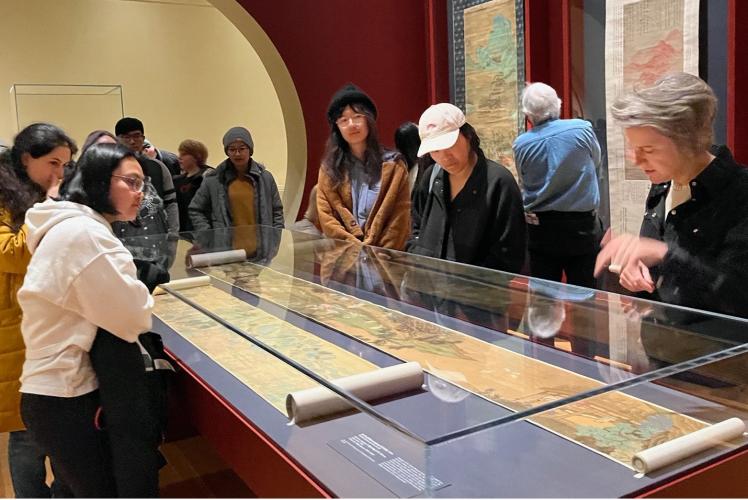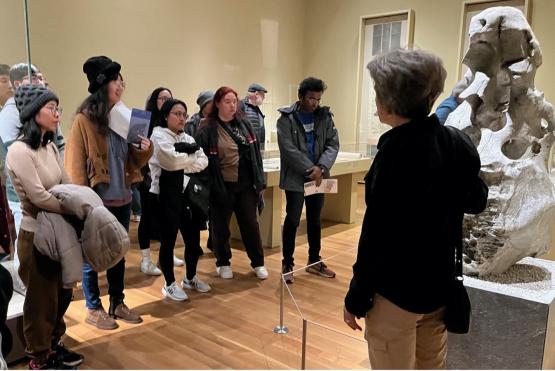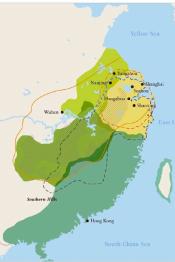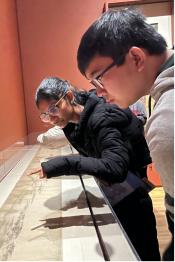
OHIO students visit “China’s Southern Paradise” exhibit at the Cleveland Museum of Art

On December 3, students from the Chinese language program in the Linguistics Department, Chinese Language Student Association, International Student Union, and a few community members went on a field trip to visit the Cleveland Museum of Art (CMA) for a major Chinese art exhibit: “China’s Southern Paradise: Treasures from the Lower Yangzi Delta.” The group was very lucky to be greeted at the museum by Dr. Clarissa von Spee, CMA’s James and Donna Reid Curator of Chinese Art. Under the guidance of Dr. von Spee, the group toured this once-in-a-lifetime Chinese art exhibit.
The exhibit includes more than two hundred and forty pieces of important Chinese art from more than 40 international museum and university collections in the US, Canada, Europe, China, and Japan. Some of the pieces are rarely displayed to the public. The timeline stretches across five millennia from the Neolithic time to the 18th century, and the genres range from painting, calligraphy, rare prints, jade, bronze, ceramic, bamboo, etc.
Yi-Ting Wang, instructor in the Linguistics Department and advisor of the Chinese Language Student Association, organized the trip.
“When I first heard about this exhibit, I think it is a great opportunity, as well as an equitable way, for our students to see and experience 5000 years of Chinese culture before the twentieth century all at once right here in Ohio,” Wang said. “Chinese is one of the critical languages and a pretty cool language in itself.”
With the support of Diane Cahill, Director of International Student and Scholar Services, the Chinese Language Student Association and the International Student Union planned the trip. There were 48 participants on the trip in total.

Noelle Flarey, a freshman majoring in biological sciences and a student in elementary Chinese, said she signed up for the trip because she loves art and Chinese culture.
“I thought it was a special opportunity to see some historical pieces of artwork from the Yangzi Delta,” Flarey said. “The scrolls and pottery were not only beautiful, but also told a unique story about that time period.”
Kyra Jeffers is a senior English creative writing major and a student in the advanced Chinese class.
“I also really loved getting to read the stories behind some of the pieces while I was there,” Jeffers said. She added that she “almost never went to museums and thought it would be extra fun to get to see some unique Chinese art and learn some of the history behind the pieces.”

Manoj Kumar Ganesan, a first-year chemistry and biochemistry Ph.D. student from India, said that some aspects of the exhibit came as a surprise.
“I thought I would only visit the Chinese artifacts, but I got [the] chance to visit other parts of the museum too,” Ganesan said. “The curator, Dr. Clarissa von Spee, explained [the objects] very well. . . It felt calm and amusing while looking at the nature paintings. I was surprised to see Tamil artifacts (my culture) nearby the Chinese artifacts on the second floor.”
Xuanxuan Li and her family participated in the trip as community members and the exhibit offers an opportunity to introduce cultural heritage to the younger generation.
“I knew it was creating beautiful memories and learning opportunities for my children,” Li said. “This event has brought us closer together, deepened our friendship, and enriched our knowledge and aesthetic appreciation.”

After the museum, the group stopped by downtown Cleveland’s Asia Plaza to visit Asian restaurants, shops, and grocery for the Chinese language students to practice their language skills and so everyone could grab some food before hitting the road back to campus.
“I also really enjoyed getting to go to the Asian market after and was happy to get several new snacks to try,” Jeffers said.
Ganesan found that “almost everything required for Asian cuisine was there.”
Three graduate teaching assistants in the Linguistics Department, Ruitong Zhu, Qianqian Zhang, and Mingzhen Cheng also served as the chaperons for the trip.
“As a Linguistics graduate student and Chinese language teaching assistant, this trip reinforces what I have learned in my coursework and through real-life experiences--learning a language does not only happen in the classroom; the field trip serves as an effective way to make the language and culture behind it more tangible and memorable,” Zhang said.
“The field trip overall was very informational, accommodating, and quite enjoyable,” Flarey said.
Ganesan added: “although it was a six-to-seven-hour trip, it was worth taking a break during the long semester.”
Santiago Zavala Segovia, a sophomore in Linguistics and president of the Chinese Language Student Association, is looking forward to rolling out more programming to support the language learning in spring.
“I am happy to see a successful end to our semester programming,” Segovia said. “This trip came about through the hard work of our advisor, Yi-Ting Wang, and the support of the International Student Union. And as always, I'd like to thank our officers, Jack Wynn, Zinia Sharmin, and Caroline Rhude for their work this semester. I look forward to stepping outside the classroom again very soon--there are so many exciting ways to engage with the language that we've yet to see.”
